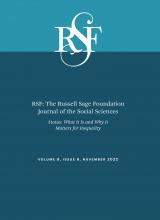Research Article
Open Access
Inequality and the Status Window: Inequality, Conflict, and the Salience of Status Differences in Conflicts over Resources
Kevin T. Leicht
RSF: The Russell Sage Foundation Journal of the Social Sciences November 2022, 8 (6) 103-121; DOI: https://doi.org/10.7758/RSF.2022.8.6.06
Kevin T. Leicht
aProfessor and past chair of the Department of Sociology at the University of Illinois Urbana-Champaign, United States

REFERENCES
- ↵
- Accominotti, Fabien,
- Freda Lynn, and
- Michael Sauder
- ↵
- Anderson, Cameron,
- Daniel R. Ames, and
- Samuel D. Gosling
- ↵
- Anderson, Elijah
- ↵
- Arum, Richard, and
- Josipa Roksa
- ↵
- Bell, Daniel
- ↵
- Board of Governors of the Federal Reserve System
- ↵
- Brooks, Clem, and
- Elijah Harter
- ↵
- Bullock, Heather E.,
- Karen Fraser Wyche, and
- Wendy R. Williams
- ↵
- Butterick, Nicholas, and
- Shigehiro Oishi
- ↵
- Cikara, Mina, and
- Jay J. Van Bavel
- ↵
- Correll, Shelley J., and
- Cecilia L. Ridgeway
- ↵
- Cote, Stéphane,
- Julian House, and
- Robb Willer
- ↵
- Cramer, Katherine J
- ↵
- Destin, Mesmin,
- Régine Debrosse,
- Michelle Rheischmidt-Same, and
- Jennifer A. Richeson
- ↵
- ↵
- Domhoff, G. William
- ↵
- Downs, Anthony
- ↵
- EU-SILC
- ↵
- ↵
- Fiske, Susan T
- ↵
- Frank, Robert H
- ↵
- Frank, Robert H
- ↵
- Frank, Robert H., and
- Phillip J. Cook
- ↵
- ↵
- Gilens, Martin
- ↵
- ↵
- Hacker, Jacob, and
- Paul Pearson
- ↵
- Hahl, Oliver,
- Minjae Kim, and
- Ezra Zuckerman Sivan
- ↵
- Halpern, Jake
- ↵
- Hawdin, James,
- Colin Bernatzky, and
- Matthew Costello
- ↵
- Hochschild, Arlie R
- ↵
- ↵
- Hundley, Greg
- ↵
- International Social Survey Programme (ISSP)
- ↵
- Inzlicht, Michael, and
- Toni Schmader
- ↵
- Israel, Emil, and
- Amnon Frenkel
- ↵
- ↵
- Johnson, Wendy, and
- Robert F. Krueger
- ↵
- Kelly, Nathan R
- ↵
- Koenig, Biko
- ↵
- ↵
- ↵
- Lachman, Margie E., and
- Suzanne L. Weaver
- ↵
- Leicht, Kevin T
- ↵
- Leicht, Kevin T
- ↵
- ↵
- Lowery, Brian S.,
- Eric D. Knowles, and
- Miguel Unzueta
- ↵
- Manza, Jeff, and
- Clem Brooks
- ↵
- Massey, Douglas S., and
- Nancy Denton
- ↵
- McPherson, Miller,
- Lynn Smith-Lovin, and
- James M. Cook
- ↵
- Mendelberg, Tali
- ↵
- Milanovic, Branko
- ↵
- Mintzberg, Henry
- ↵
- Morrison, Kimberly Rios,
- Nathanael J. Fast, and
- Oscar Ybarra
- ↵
- Mutz, Diana C
- ↵
- Niehues, Judith
- ↵
- Nishi, Akihiro,
- Hirokazu Shirado,
- David G. Rand, and
- Nicholas A. Christakis
- ↵
- Norton, Michael, and
- Dan Ariely
- ↵
- O’Connor, James
- ↵
- Phillips, Kevin
- ↵
- Piff, Paul K.,
- Michael W. Krause, and
- Dacher Keltner
- ↵
- PSID
- ↵
- ↵
- Ridgeway, Cecilia L., and
- Hazel Rose Markus
- ↵
- Ridgeway, Cecilia L., and
- Sandra Nakagawa
- ↵
- Rodríguez-Bailón, Rosa,
- Ángel Sánchez-Rodríguez,
- Efraín García-Sánchez,
- Katerina Petkanopoulou, and
- Guillermo B. Willis
- ↵
- Roex, Karlijn L. A.,
- Tim Huijts, and
- Inge Sieben
- ↵
- Rubens, Jim
- ↵
- Sakamoto, Arthur
- ↵
- Sarachek, Bernard
- ↵
- Schmader, Toni,
- Tara C. Dennehy, and
- Andrew S. Baron
- ↵
- ↵
- Schor, Juliet
- ↵
- Schor, Juliet
- ↵
- Schumpeter, Joseph
- ↵
- Schwalbe, Michael, and
- Heather Shay
- ↵
- Scott, James C
- ↵
- Shapiro, Thomas
- ↵
- Stephens, Nicole M.,
- MarYam G. Hamedani,
- Hazel Rose Markus,
- Hilary B. Bergsieker, and
- Liyam Eloul
- ↵
- ↵
- Stephens, Nicole M.,
- Hazel Rose Markus, and
- Sarah S. M. Townsend
- ↵
- Stephens, Nicole M.,
- Sarah S. M. Townsend, and
- Andrea G. Dittmann
- ↵
- Stephens, Nicole M.,
- Sarah S. M. Townsend,
- Hazel Rose Markus, and
- L. Taylor Phillips
- ↵
- Tóth, Gergő,
- Johannes Wachs,
- Riccardo Di Clemente,
- Ákos Jakobi,
- Bence Ságvári,
- János Kertész, and
- Balázs Lengyel
- ↵
- Trump, Kris-Stella
- ↵
- U.S. Census Bureau
- ↵
- U.S. Census Bureau
- ↵
- U.S. Census Bureau
- ↵
- Wilkinson, Richard G., and
- Kate E. Pickett
- ↵
- Wilson, William Julius
In this issue
Inequality and the Status Window: Inequality, Conflict, and the Salience of Status Differences in Conflicts over Resources
Kevin T. Leicht
RSF: The Russell Sage Foundation Journal of the Social Sciences Nov 2022, 8 (6) 103-121; DOI: 10.7758/RSF.2022.8.6.06
Jump to section
- Article
- Abstract
- INEQUALITY AND SOCIAL STATUS: PRELIMINARY OBSERVATIONS
- WHY THE DISCONNECT? THE CONCEPTS OF STATUS WINDOWS AND STATUS OVERLAP
- SOCIAL STATUS AND SOCIAL NETWORKS IN RELATION TO STATUS WINDOWS AND OVERLAP
- FURTHER OBSERVATIONS: HIGH INEQUALITY LEADS TO ENHANCED STATUS FOCUS, NOT LESS
- SOCIAL STATUS, STATUS WINDOWS, AND INEQUALITY PARADOXES: THREE ILLUSTRATIONS
- CONCLUSION
- REFERENCES
- Figures & Data
- Info & Metrics
- References
Related Articles
- No related articles found.
Cited By...
- No citing articles found.





